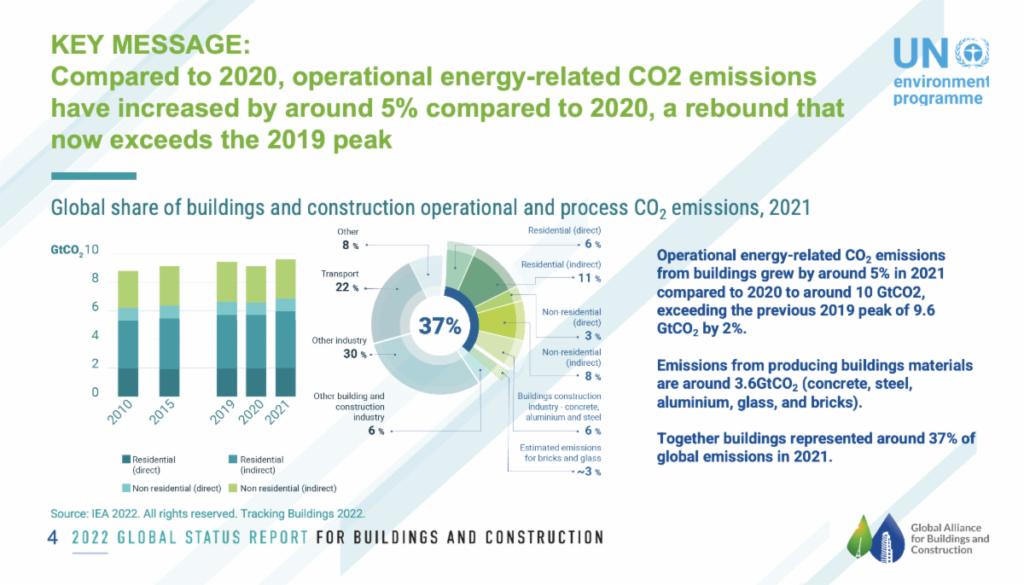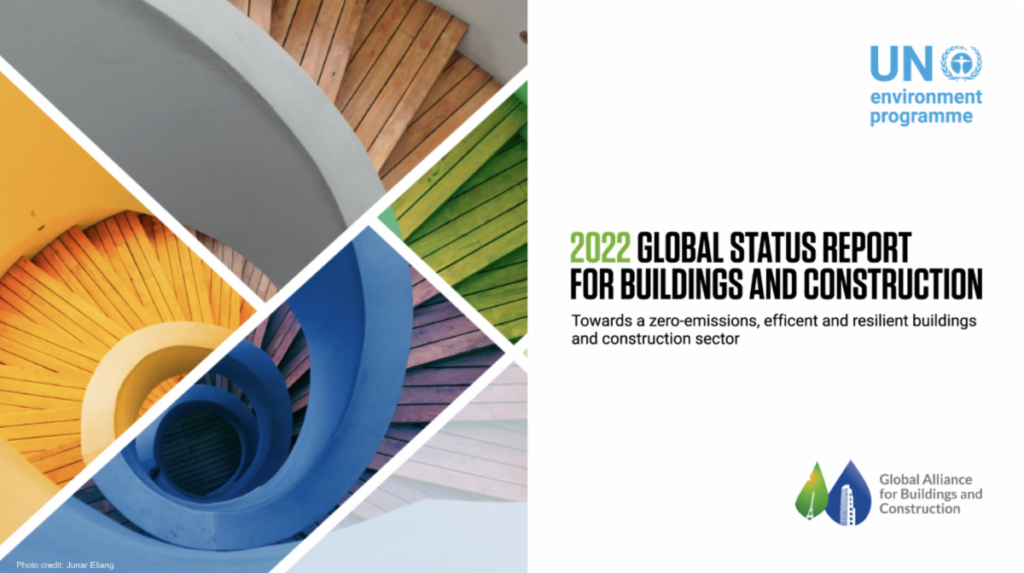Off-track buildings emissions: reached the historical maximum of 10GtCO2
UNEP presents the Global Status Report 2022 for Building and Construction at COP27
(sustainabilityenvironment.com) – Although investments in energy efficiency in buildings have increased to unprecedented levels, emissions from buildings seem unstoppable or worse. Last year, CO2 emissions related to the construction sector increased by 5% compared to 2020 and by 2% compared to the pre-pandemic peak of 2019. We are talking about 10 GtCO2 equivalents of operational emissions. The only production of building materials such as steel, iron, cement, aluminum, glass and bricks is around 3.6GtCo2.
To underline the dramatic reality of the construction sector is the Global Status Report 2022 for Building and Construction presented today by UNEP, the United Nations Environment Programme, at COP27 in Egypt. The report prepared by the Global Alliance for Buildings and Construction (GlobalABC), one of the participants in the #BuildingforCOP coalition, in collaboration with the IEA – InternationalEnergy Agency.
“Years of warnings about the impacts of climate change have become a reality,” said Inger Andersen, Executive Director of the United Nations Environment Programme (UNEP). “If we do not rapidly cut emissions in line with the Paris Agreement, we will be in deeper trouble.”
Today buildings represent in fact 37% of global operational CO2 emissions, sucking 34% of energy demand. In fact, we have reached a new peak in emissions from buildings, which significantly distances us from the target of decarbonisation by 2050.
Increased investments in efficiency but also increases the built area

Investments in building energy efficiency have gone up by unprecedented levels, rising by 16 per cent in 2021 over 2020 levels to USD 237 billion. Unfortunately, however, the land consumption and the occupied area also exceeded the efforts for efficiency.
The intensity of the emissions of the buildings of the entire compartment has been set since 2021 from 43 kgco2/ sqm to 40 kgco2/ sqm. In the same period of time also the energy intensity decreased from 153 kWh per square meter to 152. However, the growth of the built surface is overcoming every effort.
The increase in global gross floor area between 2015 and 2021 is the equivalent to the total land area covered in buildings in Germany, France, Italy and Netherlands; if it were built on one level, at around 24,000 sq. km.
As the report points out, the construction sector is too significant to be ignored. “The buildings sector represents 40 per cent of Europe’s energy demand, 80 per cent of it from fossil fuels. This makes the sector an area for immediate action, investment, and policies to promote short and long-term energy security”.
The solutions suggested by the report
But solutions exist, as the report shows. The rising costs of fossil fuels, for example, due to the war in Ukraine and the crisis of the cost of living are providing incentives to invest in energy efficiency, despite the erosion of purchasing power and the impact of labour and materials may slow investment.
“The solution may lie in governments directing relief towards low and zero-carbon building investment activities through financial and non-financial incentives,” continued Andersen.
Equally important for reducing emissions from buildings and the entire sector is the inclusion of the Nationally Determined Contributions (NDC) under the Paris Agreements and mandatory energy codes for each building. The number of NDCs that mention buildings grew from 88 in 2015 to 158 in 2021. However, progress on buildings and construction policies and action remains slow. Over the same period, the number of countries with building energy codes rose from 62 to 79. However, only 26 per cent of countries have mandatory building energy codes for the entire sector. Progress on specific policies and actions related to the sector is still too slow. To achieve decarbonisation by 2050, it is essential to cut emissions from buildings, improve energy performance, reduce the carbon footprint of building materials, Increase political commitments and increase investment in efficiency.
Within 2060 will double the use of raw resource

The Global Status Report 2022 for Building and Construction also addresses the issue of building materials, responsible for their operational process (from extraction to construction) of 9% of total CO2 emissions related to energy. The estimates speak of a doubling by 2060 of the use of raw resources such as steel, cement and concrete, already today the main responsible for greenhouse gas emissions. It becomes essential to switch to alternative materials by involving the construction and real estate industries in the process, to implement zero emissions strategies for both new and existing buildings.
Fast-growing economies, such as Africa, will play a key role in the future of the industry. An estimated 70 per cent of the African building stock expected for 2040 has yet to be built. Here’s what setting the future development according to the circular economy and the use of alternative materials could make all the difference.
The report in full is available at https://bit.ly/3zNkunl.






